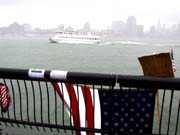Paul Amico didn’t know a plane had hit the World Trade Center on Sept. 11; he just saw smoke and knew it meant trouble.
The sun shone bright down on the smooth surface of the Hudson River that morning, yet streaks of ferry wakes cut across the Hudson like knife slashes as the flotilla of ships made for the Jersey shore. It was odd sight, partly because everything seemed reversed. Rush hour was supposed to be headed towards New York, not away.
Even from a distance, Amico, who serves on the Secaucus Board of Education, could sense the panic.
"When I saw the first tower on fire, I knew people would need way to get out of Manhattan," Amico said last week. "So I got across to the other side."
As the owner of Amico Iron Works in Secaucus, Amico is responsible for constructing ferry piers throughout the Metropolitan area for New York Waterways. His company had helped build the docks upon which these people landed in New Jersey and in New York. So he knew few people could aid the effort better than he could. While he knew he couldn’t rescue the people in the flaming towers, he had the skill and the resources to help rescue the people on the ground. Amico immediately went to New York, commandeering a ferry for the trip back to the torn city.
"I knew people were going to have a hard time getting out," Amico said.
Many people were fleeing north to ferry terminals in midtown Manhattan. Some of the docks in the area of the towers were no longer accessible because of fire, emergency vehicles and falling debris, so Amico decided to get additional docks.
He and his crew knocked down the fence to the marina in Battery Park City, which had a deep enough waterway to allow the ferries access. Then, police and other officials began to usher victims into those boats.
Amico said in those hours, he forgot about his job as a metal worker, about pay, about what he might otherwise be doing – he just thought about moving people.
"I wasn’t thinking about anything but what I had to do next," he said. "I don’t think any of those helping over there thought about the whole situation."
When under the shadow of the tower clouds, he tried not to look around too much or think much about what was going on. He certainly didn’t think of the consequences, though reports came to him at intervals, panicked voices claiming other planes had struck other places, including the Pentagon in Washington, D.C.
There was just too much to think about then and there, keeping everything moving, making certain that he and his staff saved as many lives as possible.
"I’m a man with a mission," Amico said four days later. "But when it first happened, and for many hours after the towers started to come down, I was as confused and as stunned as everybody else."
Since then, Amico, with a crew of about 50, has been installing new docks at various locations to help accommodate Fire Island ferries, and preparing other areas that may be dredged to allow for the larger vessels.
"People will have to get to and home from work," he said. "And the ferries will play a big role in doing that."
